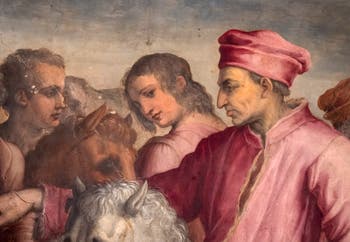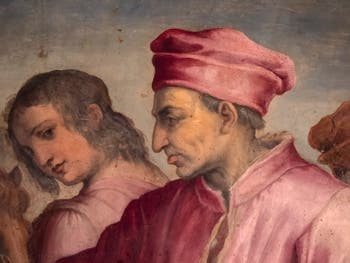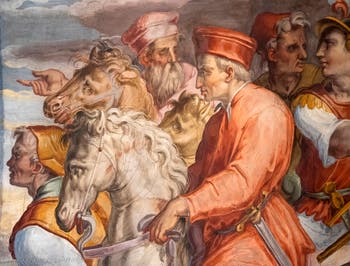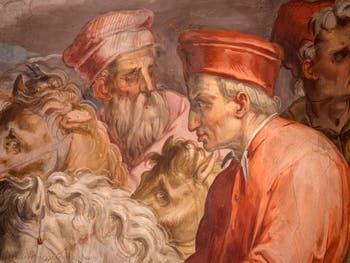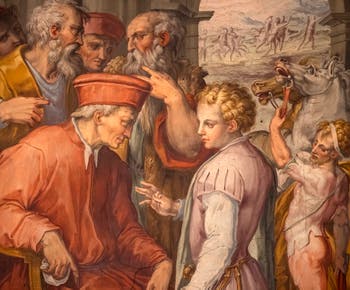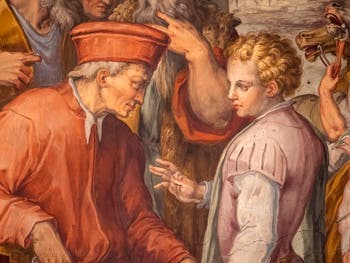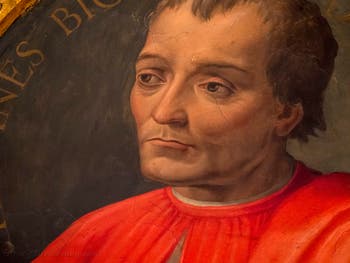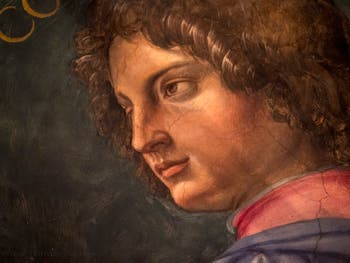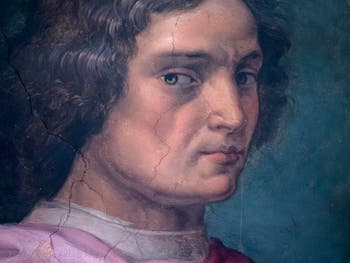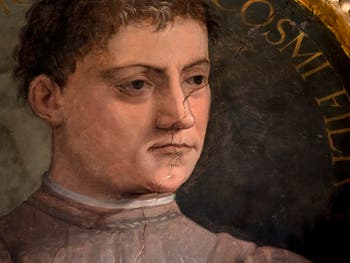Palazzo Vecchio Art Story | Location | Opening Hours Tickets | Authorizations
Art Story Five-Hundred | Tower | Vasari Halls | Dante Mask | Ghirlandaio | Bronzino Sarto Daddi | Salviati | Cortile
Vasari Halls Cosimo Elder | The Magnificent | Penelope Esther Sabines | Pope Leo X
Giorgio Vasari, Cosimo the Elder of Medici Room, Palazzo Vecchio in Florence, Italy
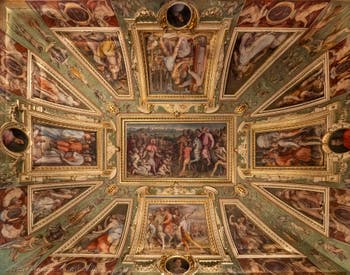
Room Cosimo the Elder The room of Palazzo Vecchio dedicated to Cosimo the Elder of Medici, the “Pater Patriæ”, the Father of the Fatherland, was painted in frescoes by Giorgio Vasari and Marco di Faenza to give glory to the first of the Medici to have played a primary role in Florence, in its economic and cultural development.
It was indeed under the impulse of Cosimo the Elder, true founder of the Medici political dynasty, that the arts developed in Florence.
Without him, we would undoubtedly not talk about the “Renaissance” and Donatello or Brunelleschi would not have had the same career without the support of Cosimo the Elder.
As it should be for a “Father of the Fatherland”, this room is dedicated to the glory of Cosimo the Elder and to the enhancement of the virtues attributed to him: Courage, Prudence, Cunning, Will, Diligence, Religion and Fame.
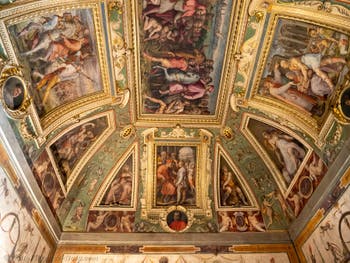
Room Cosimo the Elder Without him, we probably wouldn't talk about the “Renaissance”.
Cosimo the Elder room is adjacent to the room of Ceres.
Like the goddess Ceres, responsible for supplying men with the riches and fruits of the earth, Vasari wrote about the paintings in this piece that Cosimo the Elder, like Ceres, was the one who had brought greatness and abundance of wealth to the Florentines.
The various paintings in this room show Vasari's care to respect historical truth to identify the characters and major events that marked the life of Cosimo the Elder.
The episodes of the life of the “Pater Patriæ” represented by Vasari are as follows.
Giorgio Vasari “Return from the exile of Cosimo the Elder” Palazzo Vecchio in Florence, Italy
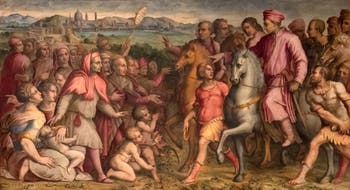
Return of Cosimo the Elde After his exile in Venice, Cosimo the Elder returned triumphally to Florence on October 6, 1434.
Vasari shows us the high-ranking Florentine and friends of Cosimo, guided by Tommaso Soderini and Niccolo da Uzzano who come to meet him to welcome him.
Cosimo the Elder is on horseback, surrounded by his relatives, including Piero de Medici, Giovanni de Medici and Rinaldo degli Albizi.
Giorgio Vasari “The Departure of Cosimo the Elder for Exile” Palazzo Vecchio in Florence, Italy
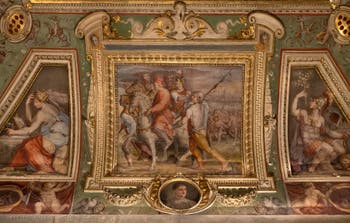
Departure of Cosimo the Elder Cosimo the Elder, accused of conspiring against the Republic and wanting to become the prince of Florence, is tried and sentenced to exile.
He left Florence as a pariah on October 3, 1433.
He first goes to Padua before arriving in Venice where he will be received with all honours.
In this painting retracing his exile, Vasari depicted alongside Cosimo the Elder of Medici Averardo de Medici, who was then under house arrest, Puccio Pucci and Cosimo's two sons, Piero and Giovanni de Medici.
Giorgio Vasari “Brunelleschi and Ghiberti present Cosimo the Elder a model of the church of San Lorenzo” Palazzo Vecchio in Florence, Italy
Vasari presents here the decision of Cosimo the Elder, after the death of his father Giovanni Bicci, to build the church of San Lorenzo.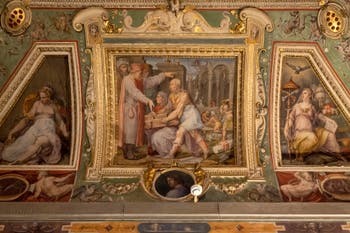
Brunelleschi and Ghiberti The sacristy where his father was buried had just been finalized, but Cosimo the Elder found the existing complex imperfect, asked Filippo Brunelleschi and Lorenzo Ghiberti to create a new church including the sacristy and the existing elements.
Brunelleschi designed the church plans while Ghiberti made the wooden model of the future church of San Lorenzo.
On Vasari's fresco, we see the two artists present the model to Cosimo the Elder.
Brunelleschi, kneeling, holds the model with Ghiberti presented to him standing.
The other characters depicted around Cosimo the Elder are, to his left, Donatello and on his right, Michelozzo.
In the background, we can see the masons and stonecutters building a church that could not be identified and the expansion and restructuring of the convent of Saint Mark.
Giorgio Vasari “Cosimo the Elder surrounded by scholars and artists” Palazzo Vecchio in Florence, Italy
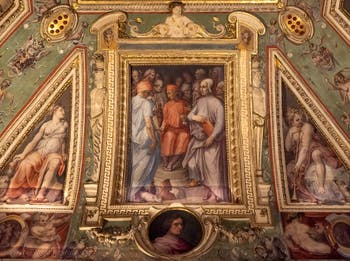
Cosimo the Elder and artists In this room dedicated to Cosimo the Elder, Vasari does not forget to celebrate his involvement as a patron for Florence.
Indeed, without the patronage of Cosimo the Elder, we would undoubtedly not speak of the “Renaissance”.
Cosimo the Elder is represented in the centre with Luca della Robia on the left and Marsillo Ficino on the right.
The two faces closest to him are those of Fra Giovanni Angelico and to his right from Donatello.
Lorenzo Ghiberti is represented in the top left corner and Filippo Brunelleschi in the top right corner.
Giorgio Vasari “Cosimo the Elder reveals to Sante Bentivoglio his origin to govern Bologna” Palazzo Vecchio in Florence, Italy
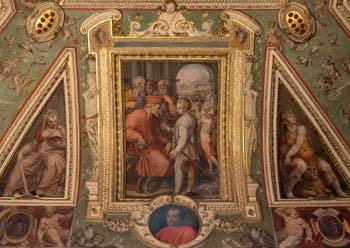
Cosimo and Sante Bentivoglio Sante Bentivoglio was raised to the court of Cosimo the Elder of Medici.
He was later recognized as the natural son of Ercole Bentivoglio and a mere citizen.
He became the lord of Bologna by succeeding his uncle Annibale I Bentivoglio after his assassination by a rival family.
He governed Bologna from 1445 to 1463 as “Gonfaloniere della giustizia”.
Vasari shows us the moment when Cosimo the Elder reveals his noble origin to Sante Benevoglio, which will allow him to govern the city of Bologna as such.
Giorgio Vasari “Portrait of Giovanni Bicci de Medici” Palazzo Vecchio in Florence, Italy
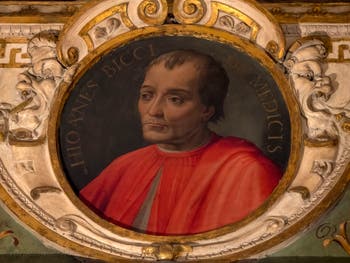
Giovanni Bicci de Medici Giovanni Bicci de Medici (1360-1429) was the father of Cosimo the Elder and, during his lifetime, was the proper head and founder of the Medici family and its wealth.
He was a wise businessman and succeeded in significantly increasing family wealth by succeeding in imposing the Medici in Florence, both in his public and political career.
To make this portrait, Vasari probably drew inspiration from the one painted by Zanobi Strozzi, which can be seen at the Uffizi Gallery in Florence.
Giorgio Vasari “Portrait of Giovanni de Medici” Palazzo Vecchio in Florence, Italy
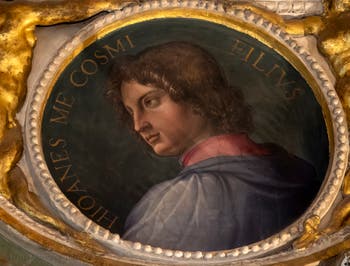
Giovanni de Medici Giovanni de Medici (1421-1463) was the youngest of Cosimo the Elder of Medici.
He was quickly introduced to business and received a humanist education.
But this did not prevent him from leading a dissolved life and pleasures.
Giovanni de Medici married Cornelia Givevra delli Alessandri, but had no children, and died at 42 years old.
Giorgio Vasari “Portrait of Lorenzo de Medici” Palazzo Vecchio in Florence, Italy
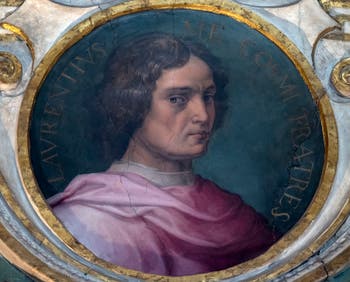
Lorenzo de Medici Lorenzo de Medici (1395-1440) was the brother of Cosimo the Elder.
The two brothers were very bounded and Lorenzo followed his brother in all his endeavours, including in his exile in Venice.
After returning to Florence, he shared with Cosimo the Elder his interest in humanist culture but was also involved at the political level which allowed him to hold several important positions in the Florence government.
Vasari was inspired by a portrait of Lorenzo de Medici who was then in the church of Santa Maria Novella.
Giorgio Vasari “Portrait of Piero I di Cosimo de' Medici also knows as the Gouty” Palazzo Vecchio in Florence, Italy
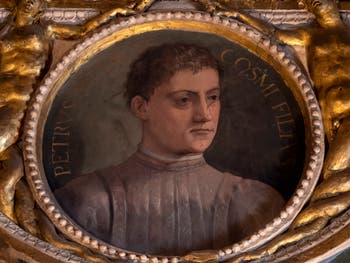
Piero I di Cosimo de' Medici This portrait of Vasari depicts the son of Cosimo the Elder, Piero I di Cosimo de' Medici (1416-1469) also knows as the gouty because of deforming arthritis that caused him to suffer all his life and made him wear this unflattering nickname.
Piero di Cosimo de' Medici was a humanist in love with the arts but was also a skilful politician.
He managed to govern Florence in the steps of his father Cosimo the Elder, remaining behind, served by the men he had put in power to serve him.
In this way, not being perceived as a man of power, he was loved by the Florentines and he protected the arts and the letters for his life.
He married Lucrezia Tornabuoni with whom he had a famous son: Lorenzo de Medici also knows as the Magnificent.
To make this portrait of Peter I de Medici, Vasari probably drew inspiration from the bust made by Mino da Fiesole in the Bargello Palace Museum.
Vasari Halls Cosimo Elder | The Magnificent | Penelope Esther Sabines | Pope Leo X
Art Story Five-Hundred | Tower | Vasari Halls | Dante Mask | Ghirlandaio | Bronzino Sarto Daddi | Salviati | Cortile
Palazzo Vecchio Art Story | Location | Opening Hours Tickets | Authorizations
Back to Top of Page


